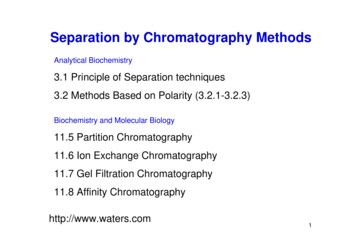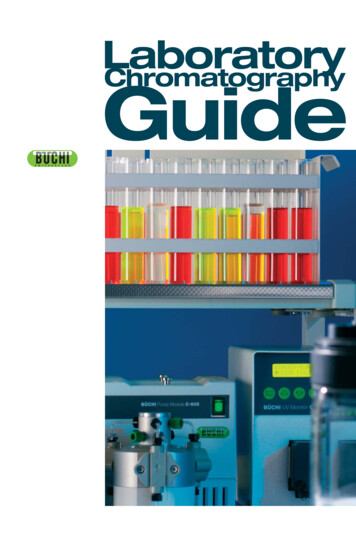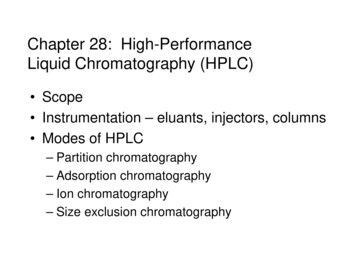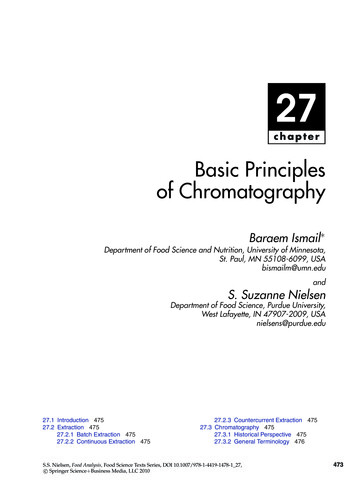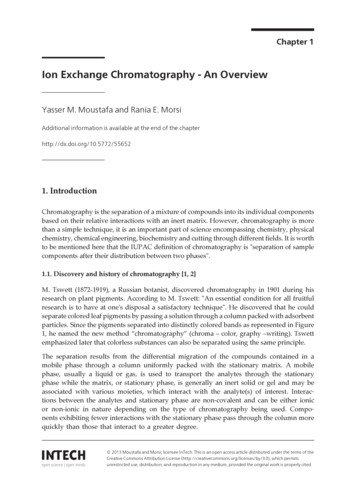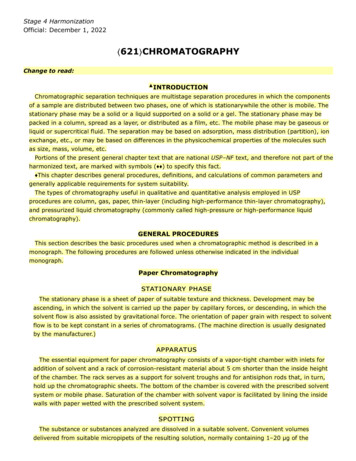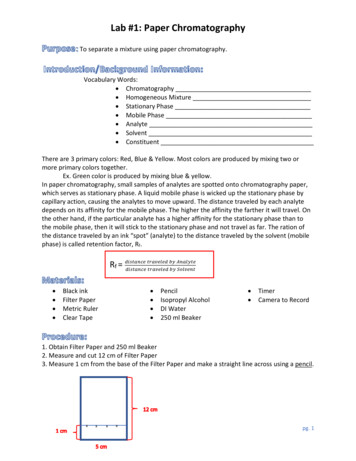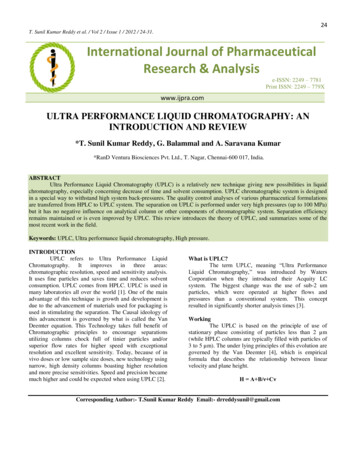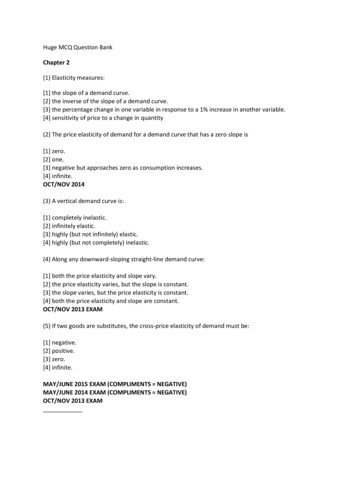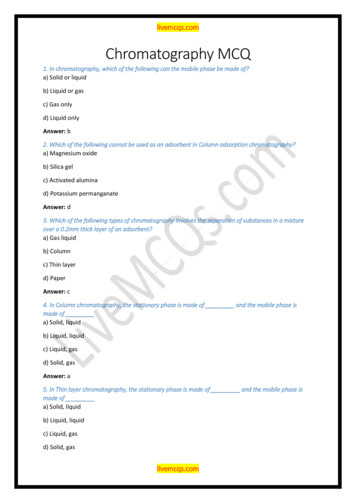
Transcription
livemcqs.comChromatography MCQ1. In chromatography, which of the following can the mobile phase be made of?a) Solid or liquidb) Liquid or gasc) Gas onlyd) Liquid onlyAnswer: b2. Which of the following cannot be used as an adsorbent in Column adsorption chromatography?a) Magnesium oxideb) Silica gelc) Activated aluminad) Potassium permanganateAnswer: d3. Which of the following types of chromatography involves the separation of substances in a mixtureover a 0.2mm thick layer of an adsorbent?a) Gas liquidb) Columnc) Thin layerd) PaperAnswer: c4. In Column chromatography, the stationary phase is made of and the mobile phase ismade ofa) Solid, liquidb) Liquid, liquidc) Liquid, gasd) Solid, gasAnswer: a5. In Thin layer chromatography, the stationary phase is made of and the mobile phase ismade ofa) Solid, liquidb) Liquid, liquidc) Liquid, gasd) Solid, gaslivemcqs.com
livemcqs.comAnswer: a6. In which of the following type of paper, chromatography does the mobile phase move horizontallyover a circular sheet of paper?a) Ascending paper chromatographyb) Descending paper chromatographyc) Radial paper chromatographyd) Ascending – descending chromatographyAnswer: c7. Liquid chromatography can be performed in which of the following ways?a) Only in columnsb) Only on plane surfacesc) Either in columns or on plane surfacesd) Neither in columns nor on plane surfacesAnswer: c8. Gas chromatography can be performed in which of the following ways?a) Only in columnsb) Only on plane surfacesc) Either in columns or on plane surfacesd) Neither in columns nor on plane surfacesAnswer: a9. In Gas-liquid phase chromatography, the stationary phase is composed of and the mobilephase is made ofa) Solid, liquidb) Liquid, liquidc) Liquid, gasd) Solid, gasAnswer: c10. Which of the following types of chromatography involves the process, where the mobile phasemoves through the stationary phase by the influence of gravity or capillary action?a) Column Chromatographyb) High Pressure Liquid Chromatographyc) Gas Chromatographyd) Planar ChromatographyAnswer: dlivemcqs.com
livemcqs.com11. Chromatography is a physical method that is used to separate and analysea) Simple mixturesb) Complex mixturesc) Viscous mixturesd) MetalsAnswer: b12. In which type of chromatography, the stationary phase held in a narrow tube and the mobile phaseis forced through it under pressure?a) Column chromatographyb) Planar chromatographyc) Liquid chromatographyd) Gas chromatographyAnswer: a13. In chromatography, the stationary phase can be supported on a solid.a) Solid or liquidb) Liquid or gasc) Solid onlyd) Liquid onlyAnswer: a14. Using Chromatogram as detector in Chromatography, a graph is obtained betweenand time.a) Quantityb) Densityc) Concentrationd) Specific gravityAnswer: c15. In older analytical methods, which of the following methods were used to allow movement of themobile phase?a) Pumpsb) Pressurec) Gravityd) Blowing air into the columnAnswer: clivemcqs.com
livemcqs.com16. Which of the following steps takes place after injection of feed in Column chromatography?a) Detection of componentsb) Separation in the columnc) Elution from the columnd) Collection of eluted componentAnswer: b17. What happens during the ‘elution from the column’ phase in chromatography?a) Components with greatest affinity elute firstb) Components with least affinity elute firstc) Components elute in a random mannerd) Components elute according to their concentration in the mixtureAnswer: b18. In chromatogram, the position of peaks on the time axis can be used to determine which of thefollowing?a) Components of the sampleb) Amount of component in the samplec) Column efficiencyd) Column resolutionAnswer: a19. In chromatogram, the area under the peak can be used to determine which of the following?a) Components of the sampleb) Amount of component in the samplec) Column efficiencyd) Column resolutionAnswer: b20. What are the uses of partition chromatography?a) Separation of amino acidsb) Analysis of closely related aliphatic alcoholsc) Separation of sugar derivativesd) All of the mentionedAnswer: d21. Which type of chromatography is used for the structural analysis?a) Column chromatographylivemcqs.com
livemcqs.comb) Paper chromatographyc) Partition chromatographyd) Affinity chromatographyAnswer: b22. Which of the following is not done using column chromatography?a) The identification of unknown compoundsb) The determination of homogeneity of chemical substancesc) Separation of inorganic cations or complexesd) Separation of geometric isomersAnswer: c23. Affinity chromatography is used for the analysis and isolation ofa) Insoluble starch substancesb) Enzyme tyrosinasec) Antibodies bound with a covalently-attached antigen on cellulose columnd) All of the mentionedAnswer: d25. Purification of enzymes and proteins is done usinga) Affinity chromatographyb) Liquid chromatographyc) Column chromatographyd) Thin layer chromatographyAnswer: a25. Which of the following is not an application of high performance liquid chromatography?a) Analysis of proteins, drugs and explosivesb) Separation of pharmaceutical drugsc) Elimination of undesirable substances from bloodd) Separation of lipids, fatty acids and steroids26. The analysis and separation of industrial products like soap and synthetic detergents is done usinga) Thin layer chromatographyb) Gas chromatographyc) Ion exchange chromatographyd) Partition chromatographylivemcqs.com
livemcqs.comAnswer: b27. Which of the following is the application of ion exchange chromatography?a) The softening of hard waterb) The demineralisation of waterc) The separation and determination of anionsd) All of the mentionedAnswer: d28. The quantitative analysis is done usinga) Ion exchange chromatographyb) Thin layer chromatographyc) Gas chromatographyd) Liquid chromatographyAnswer: clivemcqs.com
a) Affinity chromatography b) Liquid chromatography c) Column chromatography d) Thin layer chromatography Answer: a 25. Which of the following is not an application of high performance liquid chromatography? a) Analysis of proteins, drugs and explosives b) Separation of pharmaceutical
